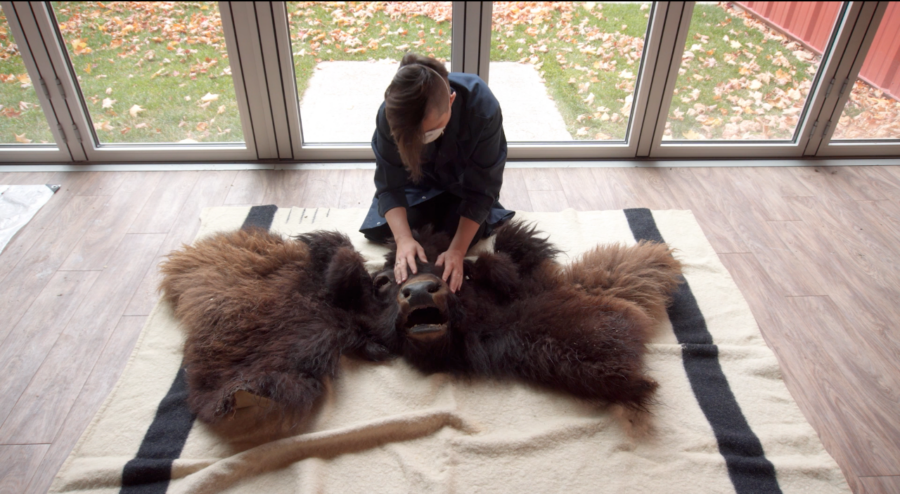
Outlaw #5
by Michelle Wilson
I went to the Manitoba Museum in 2017 to see “Outlaw #5.” He was on display as part of the Legacies of Confederation exhibit, and I was eager to see this bison bull who had haunted several Winnipeg institutions since 1912. The gallery where I found him was not large, and from the ceiling hung a surveyor’s chain, the metal bit-like links fencing in the forever arrested “Outlaw.”
Taxidermy is just the stretching of a thin layer of fur and flesh over an artful human-made form. Glass or resin eyes give the illusion of liveliness. It is seductive. There is a morbid pleasure in looking into those eyes, but eventually, you become aware that you are just seeing your reflection.
The inherited myth conveyed by the Legacies of Confederation exhibit was seductive as well. It is a myth that I, as a white settler, have inherited. This bison’s body, masculine and virile, was one of the last to resist Canada’s salvation. His kin were bought from Michel Pablo, an enrolled member of the Confederated Salish and Kootenai Tribes, and saved from destruction through Parks Canada's protection.
The outlines of this story hold up if you stand very squarely in your settler identity—If you embrace Parks Canada, the protector of Canada’s natural and cultural heritage for your enjoyment, as your inheritance. But narrow your eyes and shift your perspective. You will see that this legacy myth is only a thin shroud over the complicated tangle of colonial realities that brought this bison here.
It was almost six years ago that I went to listen to the bison at Riding Mountain National Park. I realized that to begin to apprehend another being, you must know them in community with their imbricated kin because they are continually becoming in relationship with them. In the years that followed, I have come to know that those ties do not end in “nature.” There is no divide between human and environmental history, and so to know the bison I sat with on those scorching August afternoons, I would have to look hard at the forces that brought them to this fenced pasture. It is almost six years, and I am almost ready to tell that story, but it will not fit here.
So let me focus on what this “fine specimen” can connect us to if we return him to his context. Tribal members had brought bison to the Flathead Reservation in an act of stewardship and conservation. These bison were allowed free range on pastureland that was held communally by the Confederated Salish and Kootenai Tribes. There they thrived for decades, multiplying until over 700 of them grazed the valley south of Flathead Lake. The bounds of the reservation and the tribal authority protected several generations while the US military and hide-hunters eradicated the bison outside the reservation. The Salish model of care was working. The old bulls like Outlaw #5 would sometimes stray off the reservation, and Michel Pablo or his ranch hands would drive them back. Pablo wanted to avoid conflict with his white neighbours, and when Pablo could not keep a bull within the reservation, he had him shot. When the old creature was butchered and skinned, they often found that these neighbours had filled his tough, battered hide with all kinds of buckshot and .22 calibre bullets.
In 1904, after years of bitter protest by tribal leaders and in violation of the 1855 Hellgate Treaty, Theodore Roosevelt signed the Flathead Allotment Act into law. This law forced tribal members to take individual parcels of land, opening the remaining lands within the reservation to non-Indian homesteaders. With white farmers and ranchers would come more fences and guns. The bison needed to be saved from federal American policy, though many would frame it as an inevitable tide of white expansion. The Canadian government arranged to purchase and ship 708 bison from the Flathead Reservation to the ecologically disastrous Buffalo National Park near Wainwright, Alberta. Maybe Outlaw #5 was lucky; he was one of a few dozen that Pablo had killed, butchered and skinned on the land when they proved too large and “wild” to herd and load onto carts and trains. He was not wounded with buckshot by white settlers. He did not break his own neck in a frenzy as some mothers did when they were loaded onto wagons without their calves.
Outlaw #5 carries these stories in his flesh. Still, I have to ask, what does he obscure? Taxidermy obscures the bison he was. As long as his remains are stretched over the artificial form, I am distracted by the colonial act of recreating nature in the white male vision of mastery and order. As an emblem of federal conservation, he obscures Salish efforts to protect their kin, their success in creating a pocket of free and thriving bison, and the violence and suffering that followed when settler governments wrested the bison from them. The colonial story of bison conservation is one of rescue. As Pauline Wakeham puts it, conservation narratives attempt “to overwrite colonial violence” and locate it in a distant past. The Confederated Salish and Kootenai Tribes of the Flathead Reservation and many other signatories to the Buffalo Treaty are writing a new and yet ancient story, and it is theirs to tell. It is incumbent on us to find it.
I may have inherited the myths that came with “Outlaw #5.” I have also inherited the responsibility to peel back the myths and expose the framework supporting them so that a messy, bloody, complicit truth can be known.
Michelle Wilson is an inter-media artist and mother of French/British descent. She is currently a PhD candidate in Art and Visual Culture at the University of Western Ontario.
